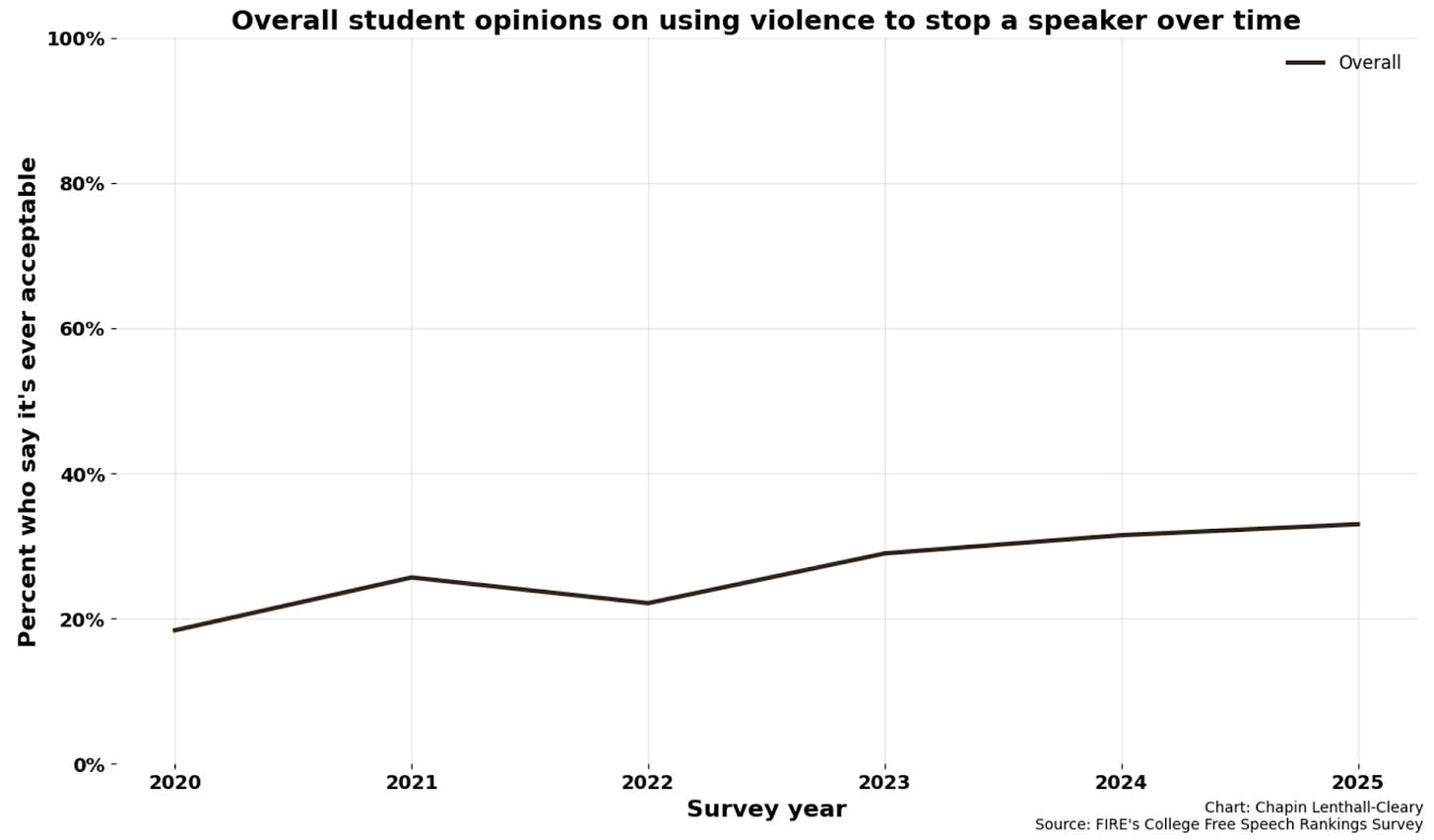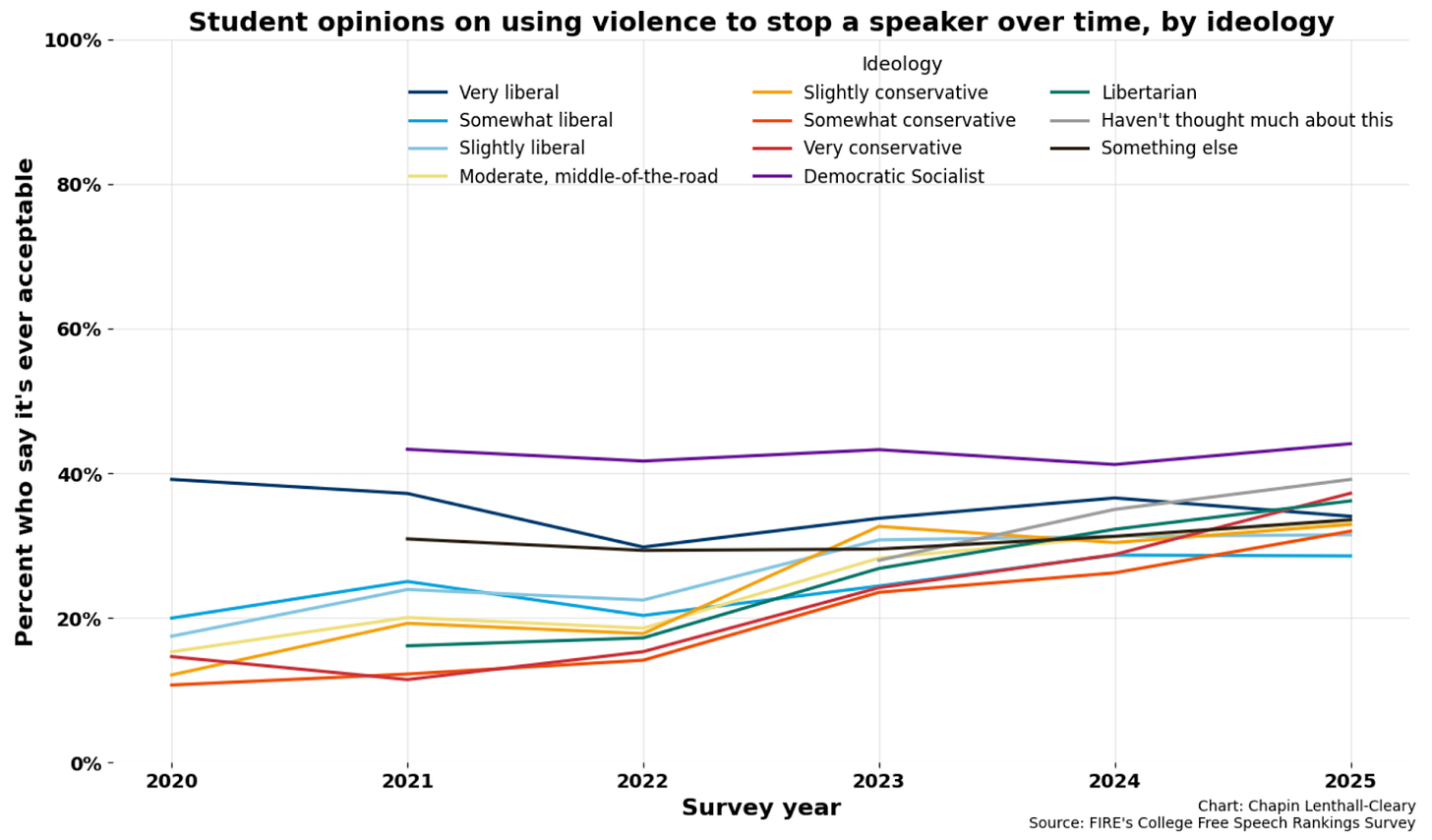Student acceptance of violence in response to speech hits a record high
Over the past 5 years, it's gone up almost 80%
The sickening assassination of Charlie Kirk at a campus speech this week has brought attention to worrying trends in political violence and the public’s stated support for it.
According to FIRE’s annual College Free Speech Rankings survey, in 2020, the national average showed about 1 in 5 students said it was ever acceptable to use violence to stop a speaker. That number has since risen to a disturbing 1 in 3 students.
While we have seen no evidence that Kirk’s shooter is a student, there’s no doubt that the 79% increase in the level of support for political violence among college students over the last 5 years has broad implications for the future of the country.
When we subdivide by party affiliation, we see a more complete story, but the trends are roughly the same.
Students who identify as “Strong Democrats” are one of the few groups that haven’t markedly increased in support for using violence to stop a speaker, but only because they started at a higher rate of acceptance. Once the second most accepting of violence, they are now the second least accepting, thanks to a rise in acceptance by other groups. In other words, they didn’t get better — everyone else got worse. But consistently the worst group of all remains those who identify as “Something else.”1
The portions of “Strong Republicans” and “Republicans” who accept the use of violence to stop a speaker have more than tripled in four years. Even acceptance among “Independents” has more than doubled. To give you a sense of how bad things have gotten, the group that currently accepts violence the least, Republican-leaning independents, would have ranked alongside those who accepted it the most back in 2020.
Now let’s take a closer look at the problem by switching from party affiliation to examining specific ideologies:
Those students who are the furthest to the left have been the most accepting of violence for as long as we’ve asked the question. That includes very liberal and democratic socialist students. But a rising tide of acceptance of violence has raised all boats. Now, regardless of party or ideology, students across the board are more open to violence as a way to shut down a speaker. What was once an extreme and fringe opinion has become normalized.
Where do we go from here? Violence is antithetical to free speech, and political violence is wholly incompatible with — and toxic to — democracy. As FIRE Executive Vice President Nico Perrino put it, it is a cancer in our body politic. Hopefully, the horrific image of the assassination of a young father, in front of his family, during a campus speech will show students who say they support violence what that actually looks like in practice.
The great innovation of free speech is that we settle disputes with words and arguments, not violence. Too many have turned away from this principle. For the sake of all Americans, we must return to it.
While we cannot know for sure what this group contains, its relative similarity to the Democratic Socialist data in the ideology chart below suggests that many “Something else” members may belong to the Democratic Socialists of America or the Working Families Party.









This is bad, sad news for our country, and for the prospects of America's continuing traditions around free speech.
I'm not sure how to improve the situation. My first thought is for high schools to teach debate and rhetoric to almost everyone, starting in middle school/ very early adolescence rather than mainly just to high school students headed towards liberal arts (or law) degrees in college. We need to teach everyone how to first understand the evidence about a topic, and argue based on evidence, rather than de-platform, shout down, or attack the people they disagree with.
As bad as the US situation is politically, it isn't only political speech that's being repressed or met with violence. The scientists and commentators who have proposed (with peer-reviewed data and math) that something other than human-caused CO2 is potentially responsible for some or all of the changes in global climate and weather are being shouted down and hounded out of university careers in Earth Science, Astrophysics, and Solar Physics. Several speakers at conferences, who agree that there are (and have always been) changes happening to the climate from entirely natural causes have been picketed, disrupted, had poster-session displays torn down and even been physically attacked.